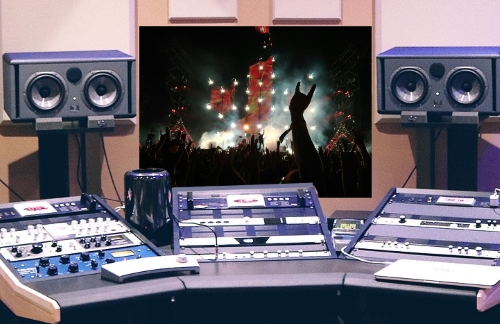Anyone who has done some studio recording or at least knows full well some of the pitfalls of the studio world.
For those of you who haven’t done, well, let me tell you.
Recording is its own planet, and it’s a world where people have pale skin, sunken eyes, hearing loss (oops – that’s common in the sound reinforcement world, too), and it can be out of touch with reality, as in, reality is sometimes the last thing that recordings attempt to convey,
But perhaps even more importantly is the element of time.
For sound reinforcement, everything is about preparation and the schedule is the schedule. The event will happen on time, barring any unforeseeable natural disasters or a singer’s voice temporarily out of commission due to “recreational consumption.”
With recording it’s as much about post-production, i.e., mastering, as it is about mixing and tracking. And, until the money runs out, time just doesn’t seem to matter, or at least as much.
Tempus Fugit
Two of my hobbies could be involved with the wedding industry if I were so inclined: photography and music. As it is, I have a string quartet that does indeed provide music for weddings.
And even though it might be possible to make more money doing photography for the same base of clients, I have chosen not to pursue such an avocation. This is for one simple reason: with photography, most of the work happens after the wedding. And brides, once they have relaxed following a year or more of planning, can be extremely picky.
Unfortunately, what was captured at the wedding is what you have to work with. Or is it? What about Photoshop? Can’t we remove that blemish? I thought my chest looked bigger in my $12,000 dress than it looks in your pictures! I told my fiancee to shave right before the ceremony!
Thus time just doesn’t seem to matter, but exacting results do. The only limit is the client’s budget, and some of them are willing to spend quite a bit on stuff like this.
But with the quartet, the work happens on the front end. We plan with the client to provide the music they want, we rehearse, we prepare for the gig, and we do the gig. Once it’s over, it’s over. We pack up our instruments, get some of the killer food (wedding food is usually pretty darned good), have a half a glass of wine, and we’re out of there. (Oh yeah, and we pick up our check.)
Part of the reason this works is that the music is an integral part of the ceremony, providing the mood, enhancing the emotions, and providing a backdrop to the couple’s special day along with flowers, bridesmaids’ dresses, decorations, etc.
Music is special. And whatever minor mistakes we might have made are lost to history, unless the event was videotaped. Interestingly, most of the ones for which we’ve provided music have not been videotaped, at least not professionally.
The Curtains Open At 8pm—Ready Or Not
But beyond the fact that once the gig is done, it’s done, there is a certain way of thinking that develops as one gains experience in live sound. The best way I can describe it is efficiency. Problems need to be solved quickly and “without a lot of moaning and groaning.”
And some of the problems are major. But with a knowledge of the basics, a handle on “the way of the road” and the right attitude, everything can be fixed one way or the other. And when it comes right down to it, the show must start on time.
Another cool aspect of live shows is the “rush.” When I was mixing front of house years ago, I never got tired of that electric feeling one gets just before the master mute is lifted. I mean yeah!—what’s better than being behind the wheel of a half-million dollar, multi-kilowatt system with thousands of fans there to enjoy the show? And it’s fun to participate actively in the performance by adding your expertise, sensitivity, aesthetic sense, and musical understanding to the overall show.
Sure, those things happen in the studio, too, but not live. Not in front of an audience. Not like at a sporting event or X Games or mountain climb before God and everyone. Of course the audience response is important because it energizes the performers and the crew. Seeing and hearing the throngs of people totally getting into the music, the visuals, the sound has to raise the hairs on the back of your neck.
Clearly, great, old rock ‘n’ roll bands like the Rolling Stones and Aerosmith have to be energized by the crowds or why would they continue? Don’t say money. Those guys can’t possibly need any more money. And although it’s certainly cool to hear your record on the radio, the immediate vibe brought to bear by a live performance and the risk of flying so high just isn’t there.
What Live Can Learn From The Studio
Of course there are important things that are performed in the recording studio that might help us in sound reinforcement. And indeed, many of these things are used more and more as the industry matures.
First, recordings are often done with the best microphones, clever mic techniques and good preamps. Why? Because the studio guys know that what you don’t capture at the source can’t be replaced somewhere downstream.
I think there are two reasons for this. Audiences expect better sound now than they ever have, and loudspeakers have improved quite a bit during that time, with line arrays, active systems and other innovations.So now, the improvements brought on by good microphones can translate directly to the audience experience.
Another thing to keep in mind is that as we work to create a similar soundscape to the record, in order to provide a point of reference for the audience, that sound started in the studio. The artist, producer, recording and mixing engineers worked out all those details already. Of course we can embellish, change, ignore or copy those effects, EQ, mix elements, etc. but always in reference to the “original.”
The best recordings are usually done with excellent rehearsals and pre-production. These are the times when all the kinks are worked out in the arrangements, the lyrics, vocal harmonies, etc. Perhaps there is no direct translation to sound reinforcement, other than it’s good to plan and be on top of the details.
The Word From The Top
I remember one of the answers Al Schmitt gave during a seminar when someone asked him, “What’s your secret?”
He replied that if an artist puts on the headphones for the first time in the studio and they think they sound great, half the work is already done. And today, due to the proliferation of IEM systems, the translation from the studio world is pretty direct. In other words, if artists think they sound great in their monitors on stage, they’ll perform better.
When working on a record, it’s a lot like being on tour in that everyone has to put up with each other as if they’re, a family and they all live in the same house. Personal relationships are important to form strong bonds with the goal of creating the best results, and avoiding petty politics.
Something I wish was practiced by both studio guys and live sound guys is “louder is not better.” Mainly, I think people make the mistake of thinking that if they mix loud, somehow magically the mix will be better. Trust me and lots of other fine folks: it won’t.
What makes the mix sound better is musicality, avoiding unwanted distortion, even coverage, intelligibility (for music that requires it, i.e., 95 percent of music) and a feeling of “impact.” None of those things require the sound to be particularly loud, even the “impact” one. Tasty mixing can be done with full but not overly loud volumes, and careful attention to the spectrum and how it relates to the music at hand. Some people seem to get this, but sadly many do not.
Hopefully I’ve not alienated everyone in the industry with this treatise. Instead, I hope that we can all just get along and make better sound. Let’s give it a go, shall we?




















